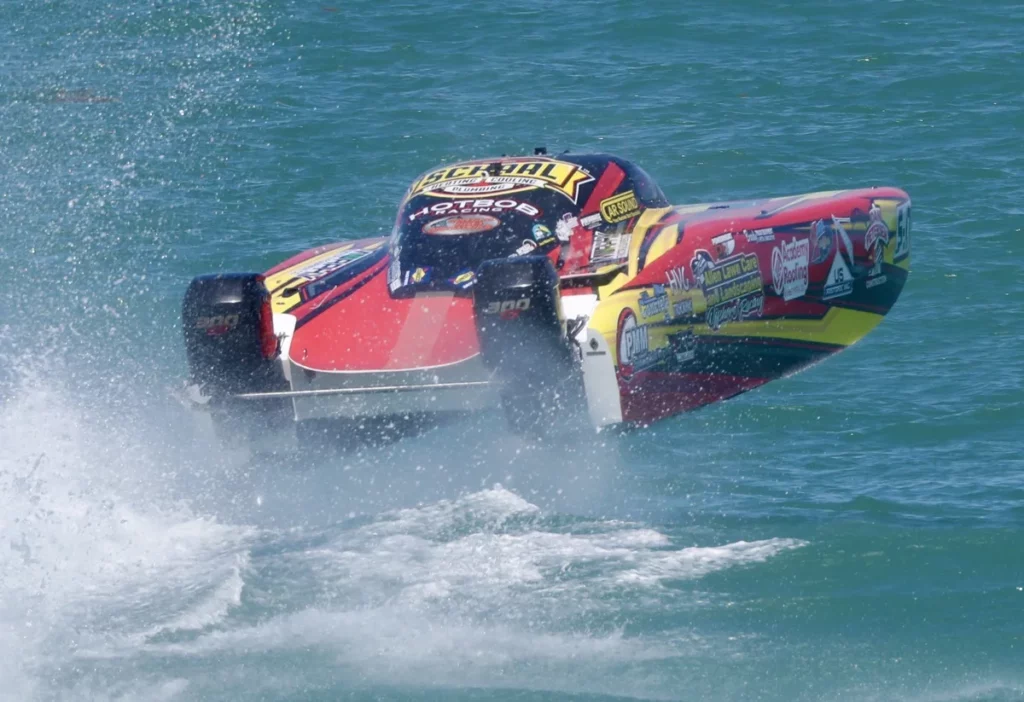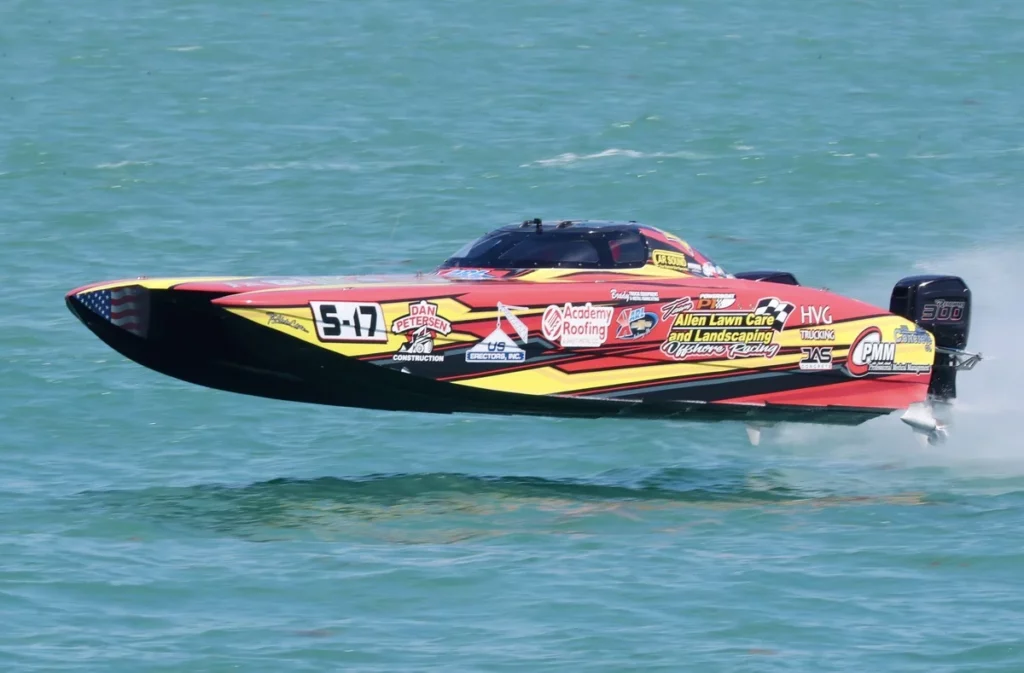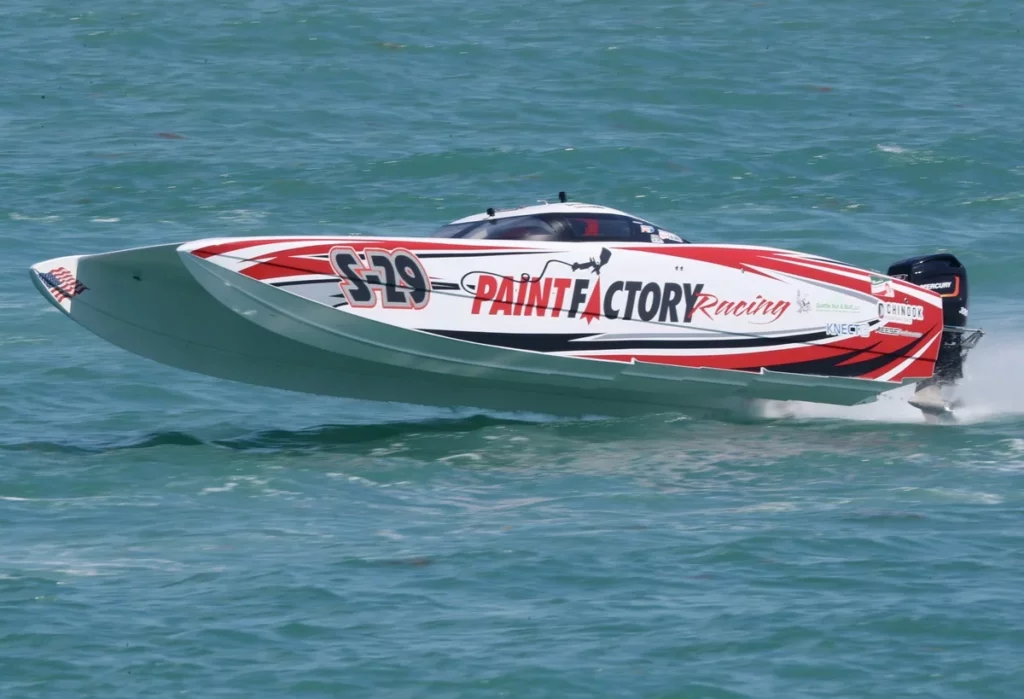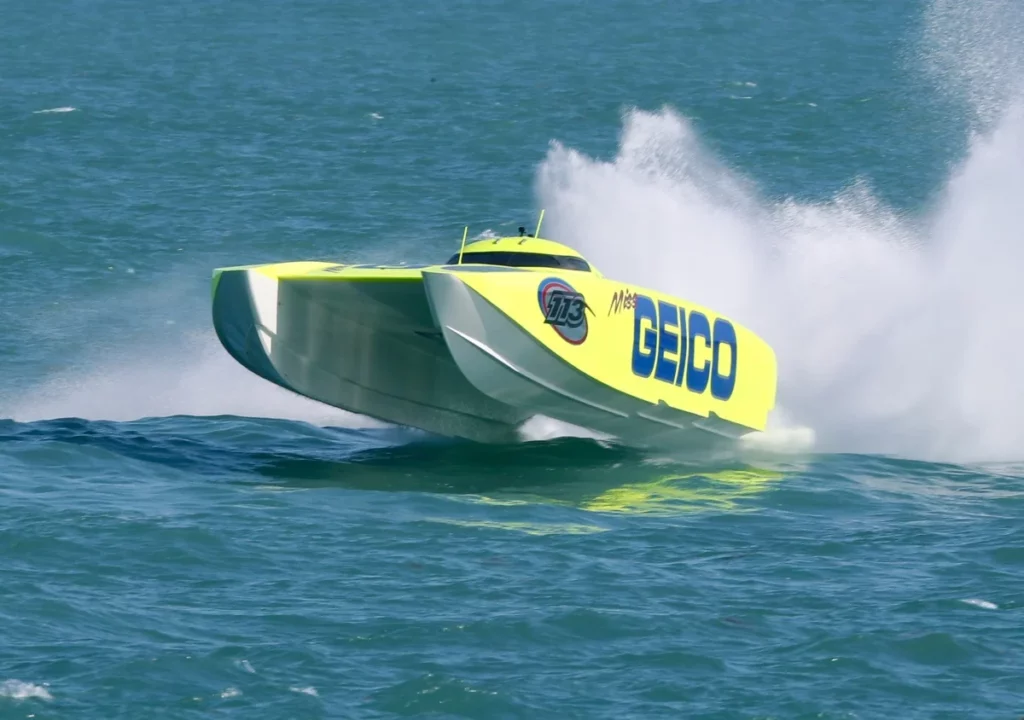The Union Internationale Motonautique (UIM) hosts the Class 1 World Powerboat Championship, an international motorboat racing event for powerboats (UIM).
Offshore Powerboat Class 1 is the world’s best class for offshore powerboat racing. It creates a stunning race series by fusing driving prowess with technology. The highest level of offshore powerboat racing, Offshore Powerboat Class 1 is frequently compared to Formula 1 auto racing.

One of the most magnificent marine motorsports is Class 1. An Offshore Powerboat Class 1 race boat features two inboard 1100 horsepower engines and is capable of exceeding 257 kilometers per hour (160 mph). The minimum weight requirement for boats is 4950 kg.
History of Offshore Powerboat Class 1 racing
Since the first race was ever documented in 1887 in Nice, France, and was run by the Paris Sailing Club, the sport of powerboat racing has seen unheard-of transformations.
The Poissy Sailing Club hosted a 62-mile race in Meulan on the River Seine in 1903, and a 230-mile race from Paris to Trouville was also won by the French. But a 22-mile race from Calais, France, to Dover, England, was the first one to receive formal recognition as an international offshore powerboat race.
The first running of the renowned Miami-Nassau race, which eventually led to the introduction of the Sam Griffith Memorial Trophy and a UIM-sanctioned World Championship in 1964, marked the beginning of the modern age of offshore powerboat racing on May 6, 1956. From 1964 through 1976, points accrued from numerous races staged at various locations across the world were used to determine the World Championship winner. From 1977 to 1991, a single event at the end of the year held a series of races to determine the champion. In 1992, the World Championship switched back to a multi-event structure.
Since the U.I.M originally approved Offshore Powerboat Class 1 in 1964, technological advancements have advanced significantly. Jim Wynne, Dick Bertram, and Don Aronow, three Americans, led the race for technological superiority shortly after it began, with Daytona, Mercruiser, and AeroMarine power plants dominating.
But the pendulum swung in the 1980s, ushering in a time when European design predominated. The James Beard-Clive Curtis Cougar catamarans, Italian producers Picchiotti and CUV, and Don Shead’s Aluminum monohulls set the pace. With the development of glass-reinforced polymer hulls, turbocharged engines, and integral surface drives, Fabio Buzzi made a significant advancement.
The 1990s saw the rise of Michael Peter’s design and the dominance of Tencara and Victory hulls, with Sterling, Lamborghini, Seatek, and more recently, Mercury sharing the power battle. Modern racers are pushing the frontiers of what is possible with their boats and cutting-edge technology in their never-ending quest for competitive greatness.
If this whets your appetite, keep a look out for the upcoming article “Powerboat Racing classes” on this website.

Main Types And Specifications Of The Boats Used For Offshore Powerboat Class 1 Racing?
Most of the vessels in the Offshore Powerboat Class 1 fleet are catamarans. They have a stepped hull design (you can learn more about stepped hulls in the “Stepped Hulls” article) and usually are made of advanced composites like carbon and Kevlar. They are typically 12-14 meters long, 3.5 meters broad, and powered by inboards with surface-piercing propellers. They weigh about 5 tonnes.
As safety has grown to be a top priority over time, modern Offshore Powerboat Class 1 boats are the safest they have ever been. An escape hatch in the hull serves as an extra measure of protection in the event of an accident, and the cockpit is reinforced to withstand the severe impacts that could happen if a boat crashes at speeds greater than 150 mph.
The fleet is made up of brands including Maritimo, MTI, Outerlimits, Tencara, and Victory. All boats have petrol engines that range from Mercury or Outerlimits V8 to 8.2 liter V12s from Lamborghini-SKEMA or SCAM, with the Victory Team using an 8.2 liter V12 from Victory.

The Bond Between Man And Machine
An Offshore Powerboat Class 1 race boat is highly technical and state-of-the-art and its overall performance is dependent on design, aero and hydrodynamics, choice of a propeller, and gear ratio selection. The crew is kept informed of the boat’s progress during a race using satellite GPS systems, trim indicators, engine data dashboards, instrument panels, and danger lights inside the cockpit.
There will be two main people in the cockpit, The driver, who navigates and directs the boat, and the throttle-man, who sets the speed by manipulating the throttles and the trim, are the two crew members of each boat. The relationship between the driver and throttle man, who navigate and control the power and must directly input to adjust the trim and drive settings during a race or official qualifying, plays a huge role in the outcome of the race.
A close working relationship and complete trust are necessary for this combination. Imagine operating the accelerator when you are driving and your passenger. The fastest drivers, in the eyes of spectators, will win if the crew simply jumps into the cockpit. This a reasonable argument, but one that ignores the expertise and professionalism of the pilots who routinely soar over the waves at speeds exceeding 160 mph(250 km/h).
To decide the race setup, including the type of propeller needed for the weather, gear ratio settings, the amount of fuel required, and race tactics, both pilots work closely with their pit crews. The choice of a propeller can make or break a championship as well as a race.

Main Rules Of Offshore Powerboat Class 1
The UIM Class 1 World Powerboat Championship consists of eight races at four locations, with races lasting roughly 55 or 75 Nm and numerous laps lasting approximately 5 Nm (including one or two mandatory long laps). The team with the most total points at the end of the season wins the World Championship. A winning team receives 20 points, a runner-up receives 15, and a third-place team receives 12 points.
The first day of a Grand Prix weekend is dedicated to registration, technical inspection, the first practice session, and driver briefings. On day two, the Edox Pole Position (qualification), which counts toward a separate championship, is held in the morning, followed by Race 1 in the late morning. The Edox Pole Position is held on the Grand Prix course, just as the practice sessions, providing the crews more time to become comfortable with the track and weather conditions and make setup decisions.
The Pole-sitter (person with the best time) lines up closest to the official start boat as it serves as the qualifying round for the starting line-up for Race 1. Teams must execute a minimum of one timed lap during the Edox Pole Position, which lasts 45 minutes. Teams are permitted to return to the wet pits to make setup tweaks, but they are only allowed a total of 10 minutes under the crane.
On day three, Race 2 is held in the afternoon after a last practice session in the morning. A Nor-Tech 3600 Supercat official pace boat sets the starting order for each race, moving at a controlled speed as it leads the boats out of the wet pits and into a line abreast under a yellow or amber flashing light. For Race 1, the starting order for Race 2 is determined by Race 1’s finishing position, and Race 1’s starting order is determined by Race 1’s finishing position.
Each race has 11–15 laps and is 55–75 Nm in duration, with one or two extended laps being required. The winner of the World Championship is decided by adding the outcomes of each race. Specific events that occur in such geographical areas serve as the benchmarks for the European Championship and the Middle East Championship.
What Are The Safety Measures In Place During Class 1 Offshore Powerboat Races?
Safety is of the utmost importance in Class 1 offshore powerboat racing, and several measures are in place to ensure the safety of the participants and the public. The UIM sets the safety standards for Class 1 racing, and these standards cover everything from the design of the boats to the safety equipment required by the drivers.
Some of the safety measures in place during Class 1 offshore powerboat races include:
- Each boat is required to have a minimum of two crew members, including a driver and a throttleman.
- All crew members are required to wear personal flotation devices and helmets.
- Boats are required to have a number of safety features, including automatic fire extinguishers and emergency kill switches.
Offshore Powerboat Class 1 Main Events
An Offshore Powerboat Class 1 season consists of a Grand Prix series, which includes two races, one official qualifying session (also known as Pole Position), and three official practice sessions. The winners of the World Championship, the European Championship, and the Middle East Championship are determined by unique events that take place in those geographical areas.
Some of the main events in the United States are as follows,
- Thunder on Cocoa Beach – Cocoa Beach, FL
- Sarasota Powerboat Grand Prix – Sarasota, FL
- Great Lakes Grand Prix – Michigan City, IN
- St. Pete Powerboat Grand Prix – St. Petersburg, FL
- Roar Offshore – Fort Myers Beach, FL
- Key West Championships – Key West, FL
Some of the most popular International Class 1 offshore powerboat races include:
- Dubai Grand Prix: Held in Dubai, UAE, this race is part of the UIM World Championship series and attracts top teams from around the world. The race is held on a 6.1 km circuit and is known for its challenging conditions and high-speed racing.
- Cowes-Torquay-Cowes: This race is held in the UK and is considered to be one of the oldest and most prestigious offshore powerboat races in the world. The race covers a distance of 200 miles and is known for its challenging conditions and unpredictable weather.
- Italian Grand Prix: This race is held in Italy and is part of the UIM World Championship series. The race is held on a 5.5 km circuit and attracts top teams and drivers from around the world. The race is known for its high-speed racing and challenging conditions.
Summary
The Offshore Powerboat Class 1 race is one of the most thrilling and accelerating boat races around the world. The races can take place in a variety of places, including the Mediterranean, the Gulf of Mexico, and the Atlantic Ocean. The sport is considered risky and demands a great degree of expertise and training to engage in.
- Types of Gas Carriers as per IGC Code – April 22, 2025
- Wind-Assisted Propulsion Systems (WAPS): A Game Changer for Maritime Decarbonization – February 6, 2025
- 10 Boat Salvage Yards in California – January 25, 2025




